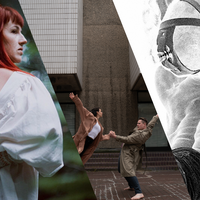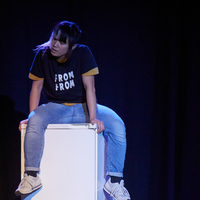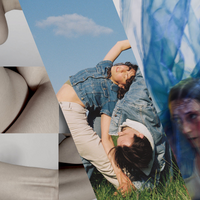Wed 17 Jan: Adél Bálint, Alice Ortona Coles and Orla Hardie

News Story
Adél Bálint Valley Fold
Alice Ortona ColesToo Much, Too Many, All the Time
Orla HardieSKUMO
It is the spectator’s own imagination that plays a central role alongside Alice OrtonaColes in her choreographed solo Too Much, Too Many, All the Time. For the first couple of minutes, the stage stands completely bare. Light itself becomes an unusual performer, guided only by the prompts that Orton’s voice challenges all of us to imagine. Her words recall snippets of long-forgotten childhood games intertwined with imaginary movements similar to the Sufi whirling practiced by the Dervishes. Finally stepping into the light, hers is a body that utterly hates reality and deeply loves dreamt up alternative existences. All that holds her together seems to be her hair – a long braided ponytail with bright red threads. Thus, Too Much…. becomes a manifesto for the overwhelming personal and political realities of a young woman in the 21st century, trying to make peace between her disjoined internal and external lives.
Watching Orla Hardie’sSKUMO, the double act performed in collaboration with Daisy Dancer, feels like being visually and emotionally immersed in the universe of Jerry Jeff Walkers 1968 song Mr. Bojangles. Their show has the same kind of playful, yet profound approach to the double nature of a performer’s life. Ranging from pure comedy to the darkest of despairs, their synchronized slapstick-inspired moves feel deeply liberating and frustratingly limitative at the same time. The stage slowly morphs into an uncanny fairground as the soundtrack turns from slow strings music to sinister laughter to TV static noise. Being a spectator of the performance of these two modern-day clowns turns out to be a nearly hypnotic experience, leaving you wanting more.
The tics and fidgets of an anxious person’s day-to-day life are the source material that is choreographically explored in Adél Bálint’sValley Fold. The work hints at a wide range of self-soothing techniques (origami, music, meditation) that might become our only weapons against all the noise and hecticness that surrounds us. Struggling to find equilibrium and serenity, performers Naya Lovell and Angélique Blasco experiment with humanising paper structures and are therefore joined on stage by Dylan Tedaldi and Adél Bálint who, dressed in white bodysuits, embody origami figures. The show raises intriguing questions about the effectiveness of battling with anxiety through the use of well-being tools, but could work at being bolder with exploring its subject and more engaging with its audience.
Daria Ancuța
Alice Ortona Coles’ brave opening solo for Resolution 2024, begins with an empty stage, dramatic lighting and a voice-over describing different performance scenarios of women in white costumes. When Ortona Coles finally emerges dressed in white, dragging a long red rope braided into her hair, she skilfully embodies these imaginary performing presences. At first stuck in body knots and struggling with her red appendage, she gradually unravels in liberating sequences of spinning. However these exhilarating moments of escape are brief and are juxtaposed with the narrated discontents of her lonely life – a long list of things she hates about living in the world. Too Much, Too Many, All the Time is a cleverly constructed work that vividly explores dance and the imagination as coping mechanisms for a woman wrestling with her lived reality.
SKUMO, a double act by Orla Hardie and Daisy Dancer, unsettles in its portrayal of a messed up, fractured unconscious. Both women are mesmerising from beginning to end in their loose limbed, seamlessly articulated and limitless movement range that draws on clowning, mime and body popping. Touching moments of tenderness disintegrate into violence and slapstick as their chaotic journey slips from lightness into darkness. A menacing soundtrack of splintered references that includes white noise, soulful music and the sinister laughing of cartoon characters further enhances the instability of the pair’s restless world. SKUMO astounds in Hardie and Dancer’s slick delivery but the overload of frantic movement and aural information is exhausting.
Origami is an unusual theme for choreography but Adél Bálint explores the art of folding paper or rather bodies into unusual shapes in Valley Fold.Frédéric Despierre’s set design features two stunning origami sculptures, their meditative, creative presence setting the tone for Bálint’s choreography. Naya Lovell and Angélique Blasco initially fold and extend their own bodies in expressive and fascinating postures before manipulating the stiffer origami figures of Bálint and Dylan Tedaldi. However the tables are turned in this activity of manipulation as Bálint and Tedaldi take on a life of their own and then get to work on Lovell and Blasco. Imaginative choreography exquisitely danced is the strength of Valley Fold, even if the underlying message is less convincing.
Josephine Leask


